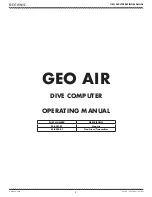
4. Cell Assembly:
The analyzers cell assembly should be maintained on an as needed basis, but no
less than once a year.
NOTE: When removing the probe assembly, approximately 130 PTFE cleaning balls will fall out.
Place a container underneath the cell assembly to catch the cleaning balls.
CAUTION: Never reuse dirty and/or damaged cleaning balls.
• Follow section VI.3 a. through e. to remove all reagent chemical and drain the measurement cell.
• Disconnect the two wires from the cell assembly (side and bottom).
• Unscrew the probe assembly taking care to catch the PTFE cleaning balls held within the cell
assembly.
• Clean the probe with a clean non-abrasive cloth. If the electrode is damaged it must be replaced.
• Inspect the inside surface of the copper cell. If there is signifi cant indications of wear or pitting,
replace the cell. If the surface appears to have little or no wear, clean the internal surface of the
copper cell with a scouring pad or similar mild abrasive.
• To remove the copper cell, unthread the four
1
⁄
4
-20 x 2
3
⁄
4
" bolts holding the bottom body, copper cell
and top body together. Take care not to let the copper cell fall once the bolts are loose.
• Replace the gasket above and below the copper cell before reassembly.
• Replace the O-ring at the base of the probe body and reinstall the probe assembly.
• Remove the Front Plug from the top body and deposit the cleaning balls through the hole in which the
Front Plug was removed. A funnel helps in this process. Once all cleaning balls have been deposited
into the cell assembly, reinstall the Front Plug.
• Rotate the motor/striker manually by hand to check for binding. If the striker will not turn freely it may
be necessary to repeat this process, or refer to section VI.6.
• Reconnect the wires to the cell assembly (side and bottom).
• Start the sample water fl ow and once water can be seen fl owing out of the drain, turn on the power to
the analyzer.
5. Motor/Striker Assembly:
In order to replace the motor or striker assembly, the measurement
cell assembly should be removed from the panel and controller and taken to a table to perform the
operation.
a. Turn off power to the analyzer and drain reagent and the measurement cell as described in
section VI.3.
b. Disconnect all wires from the measurement cell to the controller.
c. Remove screws that hold the measurement cell assembly to the panel. Remove assembly and
take to a table for this work.
d. With the motor assembly upright, remove the three screws holding the motor plate to the top
body. Lift the motor straight up and out of the body.
e. Invert the measurement cell assembly to empty the cleaning balls into a container. Remove the
valve adapter.
f. If the motor is to be replaced, remove the striker and rubber boot from the motor shaft. Install the
boot on the new motor and striker after loosening the center set screws approximately 2 turns.
g. The striker should slide onto the motor shaft when force is applied. Tighten the side set screw in
the striker until it contacts the motor shaft.
h. Fit the striker on to the motor so that a 1⁄4" space is left between the top of the striker and the
motor plate. Insert the motor/striker assembly into the measurement cell assembly by pushing on
the
motor until the motor plate is sealed on the top body.
i. Carefully remove the motor/striker from the main assembly. Lightly tighten the side set screw in
the striker. Turn the center set screw until contact is made with the motor shaft, then back out the
center set screw
1
⁄
8
to
1⁄4
turn. Loosen the side striker set screw and motor/striker assembly with
the three motor plate screws.
26
Содержание 210 Series
Страница 20: ...20 ...
















































